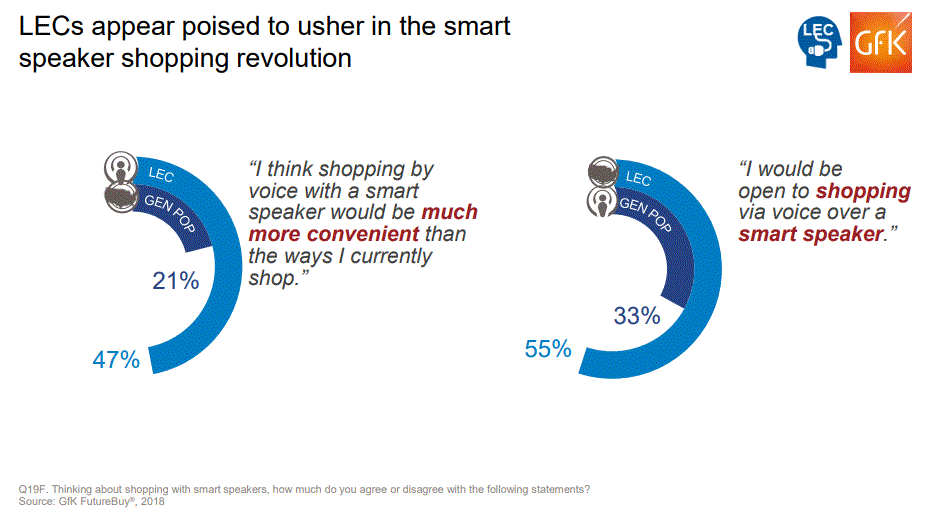Ask anyone in the radio industry what the biggest boost has been in the past year for audience building, and you’ll likely get two responses: podcasts and Smart Speakers.
It is the latter that is “bringing radio back in the home.” Now, there’s evidence that suggests radio broadcasters’ sales coffers could further grow thanks to the nascent use of Smart Speakers as a shopping tool. For that to happen, however, it must take eyeballs away from the top consumer shopping aide of today — also an essential for radio companies, with respect to audio content delivery.
An up-close look at the just-released FutureBuy study from GfK reveals that some 45% of respondents believe that their smartphones and/or tablets are “quickly becoming [their] most important” shopping tools.
That’s a huge jump from GfK’s 2017 survey, when some 29% indicated that their hand-held computer devices were their top shopping tool.
It’s rosy news this holiday shopping season for both radio and TV broadcasters, with streaming audio offering ad insertion technology that, with the push of a button, could open a new window replete with purchasing options.
But … is the purchase happening? Yes. In fact, what’s becoming common practice with more than just a few tech savvy fans is this: Consumers are using brick-and-mortar stores as a showroom, as they are not bringing the product to the register but instead going via their smartphones online to make a buy. Call it BEST or Service Merchandise for the 2010s, with every level of quality good available with a click of a button.
Oh, and the prices are cheaper online — so respondents believe. Saving money was the No. 1 reason the GfK survey takers said they shop online, with 52% of respondents saying so. A better selection (ever shop in Eureka, Calif. or what’s left of Hudson Valley Mall?) and ease of shopping online were other top reasons to shop online over a brick-and-mortar store.
What’s the advantage of in-store shopping? While “seeing the product before buying it” was tops, this clearly doesn’t prove they are going to buy it — does it?
Interesting, 44% of respondents said shopping at a store meant “getting the product sooner.” For clothing or must-haves, this shows a combination of brick-and-mortar and online shopping may make sense for U.S. families in 2019. For broadcast media, and its unique tie to digital communication devices, making retail a top category is a must. From Macy’s and Kohl’s to the local and regional retailer with online shopping options, radio and TV apps and streams are a marketer’s dream opportunity. With the holiday season approaching, a vineyard could also make a great advertising partner, with online shopping more common than ever.
“The desire or need to shop is often spontaneous, and most consumers have their smartphones nearby at all times,” said Joe Beier, EVP of Consumer Insights at GfK. “So it is no surprise that mobile technology is playing a growing – and increasingly complex – role in shopper journeys. While shopping online overall is driven largely by a search for savings, the mobile component is often about research on-the-go. And we should not see traditional retail as somehow pitted against the mobile element; often they work together – and those who can deliver a seamless experience will be more likely to capture the sale.”
While the increased prevalence of smartphone shopping grabbed the top headlines and much of the focus of the GfK report, there’s another finding that is very much worthy of marketers’ attention — and that of media industry C-Suiters.
Leading Edge Consumers were singled out in the GfK report and are “signaling an opportunity for brands/retailers to provide a curated set of product choices.”
Hello, talent endorsements. That’s certainly nothing new: KIIS-FM listeners in August 1984 could hear Rick Dees voice commercials for Southern California Chrysler Plymouth dealers. But, how about a “shopping arcade” of various products endorsed by your 6pm co-anchor on the local nightly newscast, or “sports briefs” featuring top athletic products favored by a sports talk host on one of your radio stations?
Then, there’s this “LEC” statistic definitely worth noting: While still low, Smart Speaker shopping is “much more developed” among Leading Edge Consumers in the U.S. (12%) than with the total population (3%).
As such, GfK declares, “LECs appear to poised to usher in the smart speaker shopping revolution.”

Look very carefully at the above slide. Now, share it with your GSMs.
As the Smart Speaker is the top tool bringing AM and FM back into the home, radio stations can now use it as a way to advertise goods and services that can be acquired via simple voice activation.
It’s a brave new world for radio and television, and technology is poised to bring new ROI avenues for savvy companies that understand the power of smartphones and Smart Speakers. Based on this research, the future is bright for radio and TV — thanks to new delivery vehicles with a wealth of riches associated with them.





